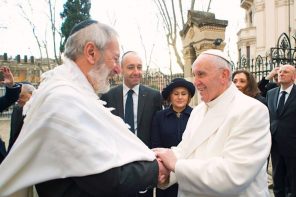In the aftermath of the fire, President Emmanuel Macron called for solidarity and challenged the French not just to rebuild the Notre Dame cathedral, but to make it more beautiful than ever (“plus belle encore”) and to do so within five years. A moonshot to the past, damage reports be damned. But is this the right response? Writing as a lover of history, the Middle Ages, and Paris—not to mention as someone who marks key points in life by visits to Notre Dame and candles lit therein—I think we should take a deep cultural breath and consider our options.
As the roof burned, it seemed one of those rare, awful moments whose only good was its potential to create community out of shared loss. The world watched and wept in sympathy as Parisians knelt in the streets, sang Ave Maria, and cried. Not just France, and not just Christians—as a symbol and as a place that welcomed (according to the most frequently cited number) 13 million visitors a year, Notre Dame is part of shared heritage, a link to the medieval past lying improbably at the heart of the world’s first great modern city. Right away, donors opened their checkbooks. In barely a day, nearly a billion dollars had been pledged.
But the relief effort raised obvious questions. In a nation roiled by violent protests against economic inequality, a topic about which President Macron had intended to speak before the fire, might this money be better spent toward alleviating widespread economic suffering and anxiety? Such a program of relief was, after all, part of Notre Dame’s original mission—the Hôtel-Dieu on the parvis before the cathedral still provides medical care to the city’s indigent. Similarly, in America, Facebook and Twitter users almost immediately began urging friends and followers to direct their money not toward Notre Dame but historically black churches in America destroyed by arson. From a call for unity to a symbol of economic inequality and racism, Notre Dame suddenly embodied the most divisive issues of our time.
And really, that is as it should be. Division is built into Notre Dame’s DNA. Originally constructed in the early Middle Ages, Paris’ cathedral was first dedicated to St. Stephen, the protomartyr, whose death by stoning is described in the Christian scriptures. Later, as the cathedral canons (the community of clerics who oversaw the day-to-day operation of the cathedral), grew more prominent, it was dedicated to both Stephen and Mary. The bishop preferred Stephen; the clerics, Mary. The clerics won that battle of names, but the fight goes on. The sculptures above the doorway in the north transept of the cathedral, which led to the canons’ residence, depicts the life of the Virgin; those above the south transept, which faced the bishop’s palace, the death of Stephen.
Some of the earliest historical memories from Notre Dame likewise do not inspire thoughts of unity. In the early 12th century, a scholar named Peter Abelard dreamed of becoming the “master,” or chief teacher, at Notre Dame. To do so, he installed himself at a church outside the city walls on Mont Saint-Geneviève, a hill from which he could gaze down on the cathedral compound and hurl ideas like intellectual mortar over its walls. After several years, he succeeded in humiliating and displacing his rivals and took his place as the cathedral’s magister, or chief teacher. Famously, Abelard seduced the niece of another cathedral canon named Fulbert. When the brilliant scholar failed to take responsibility for his misdeeds, Fulbert sent a band of ruffians to his home (just around the corner from Notre Dame, if a historical marker is to be believed) to break into his room at night and castrate him.
Years later, Abelard would return to Paris to teach, back at his first school atop Mont Sainte-Geneviève, near today what is the undergraduate library of the Sorbonne. The old church of Sainte-Geneviève has long since been demolished, replaced by the austere, domed Pantheon, where the great secular heroes of France are buried and fêted. From that temple of reason, one may still look at the cathedral and hear echoes of Abelard’s intellectual battles in the war between faith and reason, Christianity, and Enlightenment, which shaped the University of Paris and most subsequent intellectual inquiry.
In those wars, reason claimed an improbable victory in 1793, when revolutionaries rechristened the cathedral into a temple to reason. For a time, the goddess of liberty replaced the Virgin as the feminine symbol at the heart of cultic life. The statues of Jewish kings lining the West Front of the cathedral (handy signs of monarchy no matter where their point of origin) were knocked down and beheaded (their remains discovered buried unceremoniously near the fabled department store Galeries Lafayette). Eight years later, that most ambivalent of Christian leaders, Napoleon, restored Catholic practice to the cathedral where, in 1804, he crowned himself emperor in the presence of Pope Pius VII, the ceremony perhaps modeled on the 1229 self-coronation as King of Jerusalem of Frederick II, a man widely believed during his life to have been Antichrist.
By then, the cathedral was in a bad state of repair—the medieval spire gone, walls threatening to collapse, statuary destroyed or lost, inspiring a massive restoration program overseen by the architect Eugène Viollet-le-Duc. The building born of that program, the solid spiritual anchor at the heart of Paris, is the product of his vision, a hybrid of a medieval structure and a 19th-century fantasy of what a Gothic church ought to look like. Macron’s call to rebuild, to make Notre Dame more beautiful than ever, and even (bizarrely) to hold a contest to design a new spire, is very much of that spirit.
But is that response appropriate? It’s not at all a medieval reaction. If this fire had occurred in the Middle Ages, Parisians would have unceremoniously knocked down the remains and started anew according to the latest architectural fashions. Except for the door. They usually preserved the door. (At Notre Dame, for example, the south door in front of the cathedral, the one tourists entered through, had been preserved from an older incarnation of the building, the blocky Romanesque sculptures of its tympanum out of step with the rest of the church’s sinewy, willowy Gothic figures.) If we followed medieval custom, then, we’d keep that portal and build around it a futuristic glass and steel vision à la I. M. Pei.
If we do rebuild it, what will we keep? The supersessionist imagery fundamental to medieval Christianity (arguably fundamental to anti-Semitism as well) is troubling, especially in a building theoretically owned by the proudly secular French state. More sensationally, do we preserve the image of “Synagogue” on the West Front, depicted as a woman with a fallen crown, about to drop stone tablets of the law, unable to see because a serpent has wrapped itself around her eyes? The reflexive preservation of such ideas may have made sense two centuries ago, but now? At the very least, these are questions that artists, architects, historians, theologians, and—yes—politicians ought to grapple with, rather than unthinkingly follow, the instincts of one deeply unpopular president.
There are certainly other options than the erection of a new medieval building created our of equal parts history and fantasy, and there is a case to be made for magnificent ruins. Looking at the before and after pictures of Notre Dame, the sunlight shining through the roof at the central crossing onto the detritus littering the church floor, one cannot but recognize a stark beauty. It’s daunting to imagine at the center of Paris a new Colosseum or Parthenon, the wounds of fire and the ages transformed into a badge of honor, no less spiritual for being unwillingly opened to the heavens, gardens now inside and out, religious practice occurring, if at all, in the limited sheltered spaces. But it is a vision worth contemplating.




